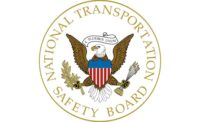“It was a dark and stormy night” might be the title of the National Transportation Safety Board’s (NTSB) report on a passenger flight from Guantanamo Bay, Cuba to Florida that ended with the plane resting in the shallow water of a river. There were no serious injuries to the 142 passengers and crew onboard, but the airplane was substantially damaged in the May 3rd incident at the Jacksonville Naval Air Station (KNIP).
The NTSB’s investigation into why the plane slid off the runway and fell into St. Johns River is ongoing, but in an agency update on the inquiry, weather conditions are prominently mentioned. Twenty minutes before the incident, thunderstorms, frequent lightning, heavy rain, wind gusts and mist were reported in the area, with five miles of visibility and a “broken ceiling of cumulonimbus clouds.”
The weather conditions caused considerable back-and-forth between the pilot and the Jacksonville approach (JAX) tower controller about which runway was in the best condition at the time, with the controller advising the pilot that both runways were “pretty rough,” and “pretty socked in.”
The next sound heard was...
The pilot was cleared to land on runway 10 and reported that he had the field in sight. According to the NTSB, the next sound heard on the frequency was the emergency locator transmitter (ELT).
The airplane plane hit a rock embankment at the end of the runway and before landing in water that was three-to-five feet deep. The impact of the engines and main landing gear could be seen on “a distinct area of disturbed rocks,” according to the NTSB. The airplane was mostly intact, but both main landing gear had separated from the airplane and were also located in the river.
Escape slides used to evacuate passengers
The two forward exits and the four overwing exits were used to evacuate passengers and crew from the airplane. The escape slide at the right forward door had deflated by the time the NTSB arrived on scene, and the escape slide at the left forward door was found fully inflated and attached to the airplane. Four rafts were deployed during the evacuation, and two sustained damage. Interviews with the flight and cabin crew have been conducted regarding the landing and evacuation.
The NTSB’s go-team included an investigator-in-charge and specialists in structures, systems, powerplants, air traffic control (ATC), survival factors, airplane performance, and meteorology. Specialists in operations, human factors, maintenance records, and flight recorders supported the investigation from other locations.
Pilot, co-pilot qualifications
Company and FAA records indicated that the captain was qualified and current in the airplane and held an FAA airline transport pilot certificate with type ratings for the Boeing B727, Boeing B737, Fairchild-Swearingen SA-227, and the Saab SF-340. He had a current FAA first-class medical certificate with no limitations or restrictions. He had worked for Miami Air since March 2008 and had about 7,500 hours of total flight experience, with about 2,000 hours as second-in-command and 1,000 hours as pilot-in-command in the B737.
The first officer held an FAA airline transport pilot certificate with a Boeing B737 type rating. He had a current FAA first-class medicate certificate with no limitations or restrictions. He was hired by Miami Air in January 2019 and had about 7,500 hours of total flight experience with about 18 hours in the B737.
Parties to the investigation are the Federal Aviation Administration (FAA), Miami Air International, CFM International, Boeing, the International Brotherhood of Teamsters, the US Navy, the Association of Flight Attendants, and the National Air Traffic Controllers Association. The investigative team was also assisted by numerous federal, state, and local law enforcement and public safety agencies.
The FDR and cockpit voice recorder (CVR) were returned to the NTSB recorders laboratory where they were downloaded. A CVR group was convened and will complete a transcript of the event. The CVR transcript will be released when the public docket is opened. Other groups include operations/human factors, ATC, weather, structures, systems, powerplants, survival factors, airplane performance, and maintenance records. Additional groups may be formed as the investigation progresses.



